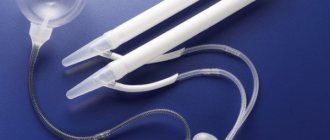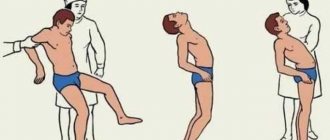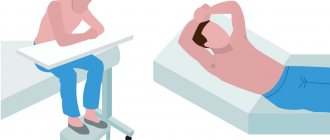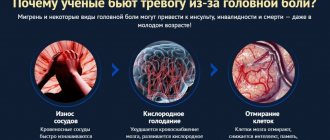Heartbeat in the ears is an unpleasant clinical symptom that may indicate problems with the health of the spinal column. Most often in young people, such manifestations indicate that there is a degenerative dystrophic lesion of the cartilaginous tissues of the cervical spine. As a result, the hemodynamics of the blood vessels that provide nutrition to the cerebral structures changes.
We invite you to familiarize yourself with the basic information on this issue. The article talks about the potential causes of tinnitus, methods of diagnosis and treatment.
Let's start with questions of anatomy and physiology. The human ear has a very complex structure. In addition to conducting and analyzing sound waves, it also has the functions of the vestibular apparatus, which is responsible for the balance of the body when walking and standing. Large blood vessels pass near the ear, supplying blood to the brain. If blood flow is obstructed, a clearly audible noise may occur. The sound of a heartbeat usually appears in healthy people in the event of a sharp expansion of the bloodstream. This condition can also be a precursor to hypertensive crisis, heat stroke, fainting, etc.
The blood supply to the ear, auditory and vestibular apparatus is provided by the posterior vertebral arteries. They also supply blood to the auditory nerve and the apparatus for analyzing sound waves located in the posterior parts of the brain. If the blood supply is disrupted, a person may experience dizziness, headaches, hearing impairment, and a feeling of stuffiness in the ears. Auditory hallucinations and effects are very common. One of them is the beating of the heart. But its distinctive feature is that the people around the patient do not record this sound. It is phantom or hallucinatory in the vast majority of cases.
The posterior vertebral arteries pass in the canal formed by the uncovertebral processes. They are located on the sides of the vertebral bodies and are connected by joints. Two branches of the subclavian artery emerge from the thoracic cavity in the area of 6-7 cervical vertebrae. They enter the uncovertebral canal (each on its own side) and go to the foramen ovale of the occipital bone. There they pass inside the skull and branch out to supply the posterior parts of the brain with arterial blood.
When the cartilage tissue of the intervertebral discs is destroyed, a decrease in their height is observed. In this case, problems arise such as instability of the position of the vertebral bodies, their periodic displacement, and degeneration of the uncovertebral joints. The internal canal in which the vertebral artery is located narrows, bends, and prevents normal blood flow. This may cause a feeling of strong pulsation in the ear on the affected side.
Pulsating sounds in the ears in people under the age of 45 in 90% of cases are associated with degenerative dystrophic disease of the spinal column (osteochondrosis). After reaching the age of 45 years, the proportion of pathologies associated with damage to the inner wall of cerebral blood vessels by cholesterol plaques (atherosclerosis) begins to increase. However, both diseases are potentially dangerous to human health and life. Posterior vertebral artery syndrome with osteochondrosis quite often provokes the development of transient cerebrovascular accident. This can cause a full-blown ischemic stroke with subsequent paralysis of the human body. This condition is equivalent to that which occurs in old age against the background of atherosclerosis of the cerebral vessels.
If you or your loved ones have a feeling of heart pounding in your ears, then do not put off visiting a doctor. It is necessary to conduct a full examination and treatment as quickly as possible. If you have pain in the neck and collar area, you feel muscle tension here, then most likely your problems are associated with damage to the spinal column. In such situations, it is important to consult a vertebrologist or neurologist. They have the necessary professional competence to make an accurate diagnosis and prescribe effective, safe treatment.
In Moscow, you can make a free appointment with a vertebrologist and neurologist at our manual therapy clinic. During the consultation, the doctor will conduct an examination and identify the potential cause of the unpleasant sound in the ears. If this condition is associated with damage to the spinal column and surrounding soft tissues, then individual recommendations for treatment will be given.
Causes of heart pulsation and pounding in the ears
Rattling in the ear is caused by various reasons; they can be divided into those that cause changes in the patency of the bloodstream and those that do not. In the first case, a narrowing, deformation or blockage of a large blood vessel occurs. As a result of this, the blood, passing through the place where the circulation is disrupted, actually makes the characteristic sound of a push. A similar effect can be heard by people nearby.
If there is no disturbance in blood circulation, the blood vessels are freely passable, then the sensation of pulsation is virtual or hallucinatory. In fact, this sound does not exist, it only seems to the patient.
The causes of heart pounding in the ears can be physiological and not related to the development of diseases:
- high ambient temperature;
- excessive physical activity;
- associated tachycardia;
- stress factors that make you nervous and worried (a large amount of adrenaline is released into the blood, it causes a short-term spasm of the blood vessels);
- blood flow to the head (for example, when being in a position where the head hangs below the legs).
Pathological causes are atherosclerosis of cerebral vessels, pressure from scar deformities and tumors located next to the arteries, increased blood pressure.
The causes of tinnitus and pulsation that are associated with pathologies of the musculoskeletal system include the following diseases:
- osteochondrosis – a degenerative dystrophic change in the cartilage tissue of the intervertebral discs, resulting in a violation of the configuration and stability of the entire department;
- protrusion of the intervertebral disc - a decrease in its height and an increase in the occupied area against the background of degenerative destruction;
- intervertebral hernia - as a complication of osteochondrosis;
- destruction of uncovertebral, facet and facet joints between the vertebral bodies;
- stenosis of the spinal canal and impaired blood supply to the vessels located inside it;
- deforming osteoarthritis of intervertebral joints;
- instability of the position of the vertebral bodies, their periodic displacement relative to each other;
- posterior vertebral artery syndrome.
It is important to understand that this is not a complete list of potential causes. The patient may be diagnosed with ankylosing spondylitis, systemic lupus erythematosus and other rheumatic tissue lesions. It is not uncommon for blood vessels to be subject to compression pressure from surrounding tissues.
Most often, such lesions occur after traumatic exposure. After stretching and rupture of the ligamentous and tendon apparatus, rough scars can form. They put pressure on the area where the blood vessels are located.
The second important factor is excessive static muscle tension in the neck and collar area. If your work involves spending a long time in a static sitting position, then there is a high probability of periodic overstrain of the muscle fiber. When the muscles fix one position of the head, a compression spasm of the cerebral blood vessels occurs. Processes that destroy the vascular wall can be observed inside. This often becomes a risk factor for the development of atherosclerosis.
In case of pain syndrome against the background of osteochondrosis and its complications, sharp spasms of the muscles of the neck and collar area are also observed. They put pressure on the arteries that supply blood to the brain. In response, the body gives the command to expand the lumen of the blood vessel. This can also cause heart pulsation and pounding in the ears.
Medical certificate
Tinnitus can be an independent nosological entity, i.e. disease, but much more often we are part of a syndrome complex of some other disease. In the field of otorhinolaryngologists, tinnitus is usually called the term tinnitus. Problems with the ears, or more precisely with the sensation of tinnitus, are not uncommon in the practice of otorhinolaryngologists. According to statistics, more than 8% of the population of developed countries experiences this unpleasant symptom, and even more people live with it without seeking qualified medical help.
Tinnitus is a complex symptom and difficult to assess objectively, since it often does not have any external stimulus. Almost all people suffering from tinnitus notice a noise in the form of a high-pitched ringing. The high-pitched sound may resemble the characteristic ringing of a bell. The causes of this symptom or disease can be very diverse, from the banal formation of cerumen plug in the cavity of the external auditory canal, to complex nervous electrochemical disorders in the central nervous system of the brain.
When there is a pulsating pounding in the ears
It is very important to record the time and circumstances under which tinnitus and pulsation occur. If this occurs during overheating, after active physical activity and gradually subsides within 10 to 15 minutes, then you should not worry too much.
If the pulsating pounding in the ear does not go away on its own within a few hours, then you should consult a doctor as soon as possible. This may be a symptom of a developing cerebral stroke. But most often, constant knocking in the ear is a symptom of a violation of the movement of blood through the posterior vertebral arteries. This pathology develops in every second patient suffering from cervical osteochondrosis. Already at the second stage of this disease, when protrusion of at least one intervertebral disc occurs, the course of the vascular bed changes sharply due to deformation of the uncovertebral canal.
The pounding of the pulse in the ear on one side indicates that only this posterior vertebral artery is affected. The sound of heartbeats in the ears on both sides indicates a bilateral pathology.
A diagnostic examination is necessary. It includes ultrasonography (USDG), a study of the patency of cerebral blood vessels. Using ultrasound, you can diagnose the posterior vertebral artery, atherosclerosis, etc.
It is also recommended to take an x-ray of the cervical spine. With its help, you can eliminate deformation of the vertebral bodies and the joints located between them. To diagnose protrusion and intervertebral hernia, it is better to conduct an MRI examination. It allows you to visualize the condition of all soft tissues of the spinal column.
Possible complications
Tinnitus may appear without warning, disappear spontaneously, or become chronic.
In addition to constant pulsation, a person may suffer from stress, sleep problems, anxiety or depression. These conditions can cause further deterioration of the heartbeat. Thus, a person finds himself in a vicious circle.
Therefore, it is important to contact a specialist who will help cope with the problem.
If the cause of tinnitus is a heart condition, if left untreated, the normal functioning of the heart can be affected, leading to serious complications over time, including:
- heart failure;
- heart attack;
- sudden cardiac arrest, death.
Heartbeat in ears while lying down at night
If a knocking sound appears in the ear while lying down, this indicates that there is instability in the position of the vertebral bodies in the cervical spine. Another probable cause is insufficiency of cerebral blood supply against the background of long-term osteochondrosis.
With degenerative dystrophic destruction of the cartilage tissue of the intervertebral discs, their gradual subsidence is observed. They do not fix the vertebral bodies and impair the patency of cerebral blood vessels.
As a result of these pathological changes, the human brain does not receive enough arterial blood throughout the day. This can manifest itself in the form of lethargy, weakness, drowsiness, decreased mental performance, headaches, dizziness, etc. When a person moves to a horizontal position, the pressure inside the vessels equalizes. Blood begins to flow to the brain and the person experiences a sensation of pulsation. Very often, the pounding of the heart in the ears at night is accompanied by insomnia and difficulty falling asleep. This is due to the fact that cerebral structures saturated with blood are actively involved in the process of activity and recovery. This also negatively affects a person’s overall well-being.
What preventative measures will be required?
To protect yourself from such an unpleasant phenomenon as pulsation in the ear, you need to take the following preventive measures:
- Maintain good ear hygiene.
- Use headphones with caution.
- Organize daily walks.
- Protect your ears from infections.
- From autumn to spring, wear a hat and scarf.
- Protect yourself from drafts and hypothermia.
- Give up bad habits.
Following these recommendations will help you maintain your health.
What to do when there is a knocking in the ear - how to treat it?
It is not possible to treat pounding in the ear separately, since it is not an independent disease, but only a clinical symptom. If you experience a knocking sound in your ear, you should seek medical help as soon as possible.
The first thing to do if there is a knock in the knot is to make an appointment with a vertebrologist. This doctor is well versed in pathologies of the spinal column. He will conduct an examination, make an accurate diagnosis, and give all the necessary recommendations for rehabilitation treatment.
At our chiropractic clinic, we treat musculoskeletal conditions, many of which can cause pounding in the ear. For example, to treat cervical osteochondrosis complicated by posterior vertebral artery syndrome, we use the following techniques:
- manual traction of the spinal column - allows you to increase the intervertebral spaces, which creates favorable conditions for the complete straightening of the discs and eliminating pressure on the surrounding soft tissues;
- osteopathy to restore microcirculation processes of blood and lymphatic fluid, which has a beneficial effect on the condition of all tissues;
- massage to relax overly tense muscles of the neck and collar area;
- kinesiotherapy and therapeutic exercises to restore normal muscle fiber tone and start the disrupted process of diffuse nutrition of cartilage discs;
- physiotherapy, laser, reflexology and much more.
You can right now make an initial free appointment with a vertebrologist or neurologist at our manual therapy clinic in Moscow. To do this, fill out the registration form located further on the page.
Diagnostics
To identify the causes of ear noise, the following diagnostic tests are used:
- complete physical examination, medical history, examination of the head and neck, determination of cranial nerve function;
- hearing test (subjective audiography);
- objective audiological examination: method of studying the auditory brainstem response (ABR) and extratympanic electrocochleography;
- computed tomography or magnetic resonance imaging of the skull;
- endoscopic nasopharyngoscopy to identify the causes of muscle noise;
- microotoscopy;
- in some cases - diagnosis of hypertension, hyperthyroidism and other therapeutic diseases;
- according to indications - spinal puncture with determination of intracranial pressure.
Treatment
Help before diagnosis
Ear congestion that occurs when the pressure changes can be eliminated on your own - to do this you need to make several swallowing movements and blow your nose. To open the lumen of the Eustachian tube, you need to close your nose and try to exhale intensely. If the discomfort is caused by a runny nose, it is recommended to drip vasoconstrictor nasal drops into the nostril on the side where the congestion is felt, then lie on your side. To identify the cause of discomfort in the ear and select a treatment regimen, you should contact a specialized specialist.
Drug therapy
Therapeutic measures for a stuffy ear are primarily aimed at eliminating the cause of the symptom. To increase the effectiveness of therapy, several drugs are combined that affect different parts of the mechanism of development of the disorder. Etiotropic and pathogenetic therapy involves the use of the following groups of drugs:
- Antibiotics
. Medicines are prescribed for purulent processes in the middle and inner ear. The otolaryngologist selects medications that do not have ototoxic properties. For mycoses, specific antifungal agents are used. - Anti-inflammatory drugs
. Usually, medications from the NSAID group are recommended, which effectively relieve swelling of the mucous membrane and eliminate congestion. The drugs have an analgesic effect, therefore they are also indicated as symptomatic therapy for severe pain. - Antihistamines
. _ Prescribed for proven allergic causes of discomfort in the outer ear. In addition, antihistamines, which relieve swelling and restore the patency of the auditory tube, are included in the treatment regimen for eustachitis. - Immunomodulators
. They are used to increase local and general protective functions of the body, accelerate regenerative processes in the epithelial cells of the hearing organ. Immunostimulants are especially effective for otitis of a bacterial and viral nature.
Physiotherapy
As a rule, the treatment plan for congestion and other unpleasant symptoms of the hearing organ includes physiotherapeutic techniques. Blowing the auditory tube according to Politzer is effective, aimed at improving the outflow of exudate from the tympanic cavity and reducing discomfort in the patient. To stimulate blood circulation and reparative processes, pneumomassage of the eardrum is performed. Complex treatment involves the use of UHF, laser effects, and microwave therapy.
Surgery
In some situations, effective therapy for ear congestion is possible only after surgical elimination of the cause. For massive purulent otitis, drainage operations are indicated to facilitate the outflow of pus and speed up the recovery period. In cases of significant enlargement of the adenoids, a tonsillectomy is performed. According to indications, correction of nasopharyngeal pathologies is prescribed - septoplasty, removal of polyps and other benign tumors, conchotomy for hypertrophic rhinitis. In some cases, reconstructive interventions in the inner and middle ear are required.










